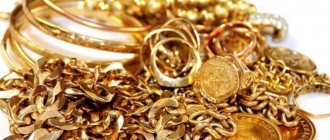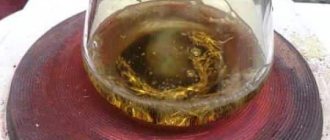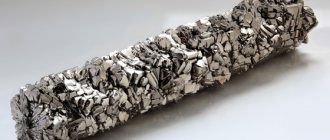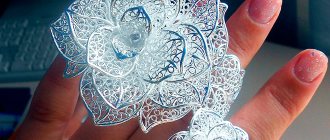Platinum is the Cinderella of the metal world. In its original state, it looked like grimy silver, which came across to the Spaniards who arrived in the New World with Columbus to get rich. The Columbia gold mines also contained “dirty silver” that miners discarded. The dirty-looking grains were difficult to separate from the gold, they melted with difficulty, and it was not easy to separate them from the gold...
Miners who called silver "plata" called the dirty gray pieces of metal "platina". Then the noble metal was “frog, rotten silver”, just silver.
The story about counterfeiters and Ural hunters
The cheap “silver” gave the counterfeiters a great idea. The annoying metal was added to gold: the color of the alloy did not change, and the fakes were of high quality.
The Spanish crown, having learned about the tricks of the scammers, ordered the “harmful metal” to be drowned. Naturally drown in the waters of the Atlantic - in Colombia and Spain. Later, the Spanish court decided to make some money on the “rotten silver” and add it to coins.
The sad story of the “metal Cinderella” ended by the 19th century.
Scientists became interested in platinum and discovered that it has a “family.” Together with the “head” there are five family members. These are rhodium, iridium, ruthenium, palladium, osmium. The classification was carried out by scientists from different countries.
Interesting: Ural hunters, encountering platinum placers, used metal grains instead of shot. It was the most expensive shot in the world.
Metal density
The density characteristic itself means the weight of a substance per unit volume. So gold has almost the maximum indicator for this parameter. So, for example, half a glass of pure golden sand will weigh about 1000 grams.
The density of gold, purified from impurities, is 19.3 g/cm3. If we talk about natural gold-bearing rocks, then the indicator is slightly lower - 18-18.2 g/cm3. This indicator allows you to conveniently extract the metal in question from rocks. He makes gold so expensive for a very small amount per gram.
Physical and chemical properties
Platinum is a noble metal, shiny, malleable, silvery-white in color.
Platinum crystals
Chemical properties of metal.
| Property | Indicators |
| Oxidation states | 0, 2, 4 |
| Covalent radius | 130 picometers |
| Electronegativity | 2.28 on the Pauling scale |
Physical properties:
- Mohs hardness 3.5;
- structure (crystal lattice) face-centered;
- density 21.1-21.45 g/cm3;
- melting point 1768.3 °C.
| Properties of the atom | |
| Name, symbol, number | Platinum (Pt), 78 |
| Atomic mass (molar mass) | 195.084(9)[1] a. e.m. (g/mol) |
| Electronic configuration | [Xe] 4f14 5d9 6s1 |
| Atomic radius | 139 pm |
| Chemical properties | |
| Covalent radius | 130 pm |
| Ion radius | (+4e) 65 (+2e) 80 pm |
| Electronegativity | 2.28 (Pauling scale) |
| Electrode potential | Pt←Pt2+ 1.20 V |
| Oxidation states | 4, 2, 0 |
| Ionization energy (first electron) | 868.1 (9.00) kJ/mol (eV) |
| Thermodynamic properties of a simple substance | |
| Density (at normal conditions) | 21.09-21.45[2][3] g/cm³ |
| Melting temperature | 2041.4 K (1768.3 °C, 3214.9 °F)[2] |
| Boiling temperature | 4098 K (3825 °C, 6917 °F)[2] |
| Ud. heat of fusion | 21.76 kJ/mol |
| Ud. heat of vaporization | ~470 kJ/mol |
| Molar heat capacity | 25.85[3] J/(K mol) |
| Molar volume | 9.10 cm³/mol |
| Crystal lattice of a simple substance | |
| Lattice structure | cubic face-centered |
| Lattice parameters | 3.920 Å |
| Debye temperature | 230.00 K |
| Other characteristics | |
| Thermal conductivity | (300 K) 71.6 W/(mK) |
| Thermal expansion | (25 °C) 8.8 |
| Young's modulus | 168 GPa |
| Shear modulus | 61 GPa |
| Volume control module | 230 GPa |
| Poisson's ratio | 0,38 |
| Mohs hardness | 3,5 |
| Vickers hardness | 549 MPa |
| Brinell hardness | 392 MPa |
| CAS number | 7440-06-4 |
We recommend: MANGANESE - the dream of steelworkers
This precious metal is practically resistant to rust. Under normal conditions, it reacts slowly with aqua regia; when heated - give it time - it will dissolve in sulfuric acid and liquid bromine. Other acids (inorganic, organic) have no effect on platinum.
Now platinum is appreciated; it is called the “queen of metals.”
Comparative analysis of melting temperatures of gold of various samples
| Gold | Silver | Copper | Zinc | Cadmium | Melting temperature |
| 999 | Trace amount | Trace amount | Trace amount | Trace amount | 1064 |
| 585 | 138 | 229 | 36 | 12 | 850 |
| 585 | 163 | 207 | 46 | 850 | |
| 585 | 125 | 205 | 85 | 830 | |
| 585 | 160 | 205 | 30 | 20 | 820 |
| 585 | 150 | 205 | 30 | 30 | 800 |
| 585 | 193 | 133 | 33 | 56 | 790 |
| 585 | 100 | 225 | 90 | 770 | |
| 585 | 104 | 176 | 20 | 115 | 710 |
Earth and star maternity hospital platinum
The main platinum deposits are located in the countries:
- Zimbabwe;
- USA;
- SOUTH AFRICA;
- China;
- Russia.
This is approximately 90% of the world reserve (according to some analysts). Others give the same 90% of platinum in nature to one South African deposits. Such strange “analytics” show that the bowels of the Earth have been explored approximately.
There are small deposits in South America, Canada and a number of countries.
We mine platinum
About interesting and important mining sites of the “queen of metals”. Platinum is found in placers and ultramafic bedrock.
World platinum production (tonnes per year) over recent decades.
The process of formation of the noble metal occurred not only on Earth. Some of the asteroids that fell to Earth were filled with platinum group metals.
South Africa
The largest “basket” on earth with platinum and platinum group metals is located in South Africa. This is the Bushveld complex. It looks like a saucer with a diameter of about 370 km. Horizons (reefs), lenses, and platinum veins stretch from the edges of the saucer to the center. Their thickness ranges from 1 to 90 meters; some reefs are mined by open-pit mining.
¾ of all platinum is mined here.
Russia
We had the richest placer deposits in the Urals. Since 1828, the country has minted platinum coins in denominations of 3, 6 and 12 rubles. For coins, native metal was used, not purified from accompanying metals. The coins were minted for only 17 years, then they began to be withdrawn from circulation.
After 100 years, the Ural deposits were depleted.
Currently, silver mining is carried out in Taimyr, on the Kola Peninsula, in the Khabarovsk and Krasnoyarsk territories.
Canada
In central Ontario, nickel and palladium are mined, and platinum is a “prize” for miners. By the way, most likely, the platinum group metals here are of extraterrestrial origin. Once upon a time a huge meteorite fell here.
The Lac des Iles mine in western Ontario uses open-pit mining for platinum group metals. Recently, an underground mine was opened here, where the content of noble platinoids is higher.
USA
There are only two mines here, both in Montana. However, the ore is rich, the content of platinum group metals is about 20 grams per ton of ore.
In 2015, a small asteroid (less than a kilometer in diameter) flew close to Earth. It differs from the mass of other celestial bodies in its “filling”. The core of the celestial stone, as astronomers have found, consists of platinum, gold and other attractive metals. It's a shame we didn't catch it...
Section question - answer
Melting point of 585 gold in degrees Celsius?
Pribrezhny Gennady Valentinovich
It all depends on what alloying additives and in what quantities are included in the alloy in addition to gold. Typically, the melt temperature of 585 sample is in the range from 700 to 850 degrees.
Melting temperature of gold at home
Jeweler, director of the Grishanov and Co. workshop
Everything depends primarily on the sample + you need to make a small addition on top, since higher heat losses are usually observed outside. 585 sample is recommended to be heated to 900 degrees, 999 to 1200 degrees, 375 to 800 degrees.
Does gold melt in a fire?
Pribrezhny Gennady Valentinovich
It all depends on how exactly the building burns and what type of product is inside it. Typically, in a serious fire, the fire can heat the room to 900-1100 degrees. Samples 585 and 375 melt at this temperature, but, if you're lucky, the product 999 samples will remain unharmed.
Melting gold at home
Does gold melt in a fire?
Jeweler, director of the Grishanov and Co. workshop
This is possible, although in practice it is rarely used due to high heat loss, as well as the risk of contamination of the product. A good fire is on coal. If heated with wood from the forest, melting will not occur.
At what temperature does gold melt at home, how to melt it?
Pribrezhny Gennady Valentinovich
Heating should be carried out with a small margin. The optimal temperature for casting 585 is 900 degrees, 375 is 800 degrees, 999 is 1200 degrees. Use a stove or gas burner to heat. You can also melt using a microwave.
Platinum for man
The scope of application of the precious metal includes the oil refining industry. Here you cannot do without catalysts containing platinum. The lion's share goes here (about half of the precious metal mined). The chemical industry uses the noble metal in the production of nitric acid.
We recommend: BERILLIUM - the metal of the present and future
Platinum is indispensable in radio engineering, electrical engineering, telemechanics, and precision instrument making.
“Silver” is used in medicine. Here, surgical instruments are made from platinum alloys. There are methods for treating cancer using cis-isomers, derivatives of divalent platinum.
The activity of the Green Party has led to an increase in consumption of the “queen of metals” in the automotive industry. Tightening standards for harmful emissions into the atmosphere has led to the equipping of cars with autocatalysts.
The Russian kilogram standard is made from an alloy of platinum and iridium.
Informative: the police and casinos use platinum-coated mirrors. From the illuminated side it works like an ordinary mirror, from the shadow side it is transparent, like glass.
Manufacturing
The same technologies are used for the production of noble alloys. Melting is carried out in graphite crucibles coated with annealed lime. Pure carbon at high temperatures can enter into a chemical reaction with heated metals and alloys. Each alloy has its own container, which is not used to create similar solutions.
Heating is carried out in induction furnaces. They heat the contents of the crucible to the desired temperature without contact at high speed.
The noble metal is melted first, as it is more resistant to exposure to air and does not create oxides. Then a ligature of other substances is added.
In the production of alloys, chemically pure metals are used - 999.9%. When creating an alloy of gold and silver, the metals are crushed, placed in a crucible and mixed, then melted. Low-melting cadmium and zinc are first fused with another component of the alloy, copper or silver. When creating alloys from metals with different melting points, they are individually rolled into very thin sheets, then stacked in the required proportions, rolled and compressed. The briquettes are placed in a crucible.
Platinum jewelry
Platinum jewelry is not very popular in Russia. Most likely, it’s a matter of habit, the belief that “if you want to look rich, wear gold.” In addition, the price of this noble metal “bites”. 1 gram costs from 5,500 to 7,500 rubles (the price largely depends on the seller’s appetites).
The fashion for jewelry comes to Russia from the West, and the fashion for platinum products has reached us. Cartier has been working with precious metal for a long time. Inserts in platinum earrings, rings, and necklaces are often made of diamonds. The spring transparency and cold fire of the stone are amazingly suited to the dispassionate purity and whiteness of platinum. Colorless or white stones look good when framed in elegant metal.
- The advantages of a platinum frame are corrosion resistance, hardness, beauty, expensive and respectable appearance.
- drawback , but a significant one. Platinum is far from being a democratic metal; not everyone can buy jewelry made of the precious metal.
Platinum alloys for jewelry
Alloys of platinum with various metals are used in jewelry. These are cobalt, copper, tungsten, iridium. They add useful properties to the alloy: improve mechanical properties, extend the service life of products, and impart softness.
The following alloy samples are accepted in Russia:
- 950 - the most popular among jewelers and consumers;
- 900 - used less frequently than 950; it has a weaker white color and less shine;
- 850 - not often used in jewelry production: the shine and whiteness of platinum is “killed” by silver.
How to replace platinum
You don’t have enough money to buy platinum jewelry, but you really want it - buy white gold jewelry. Sometimes these metals are confused.
The main difference between platinum and white gold is that there is no platinum in white gold. Technically, white gold is a jewelry alloy of gold with silver, nickel or palladium.
Recent studies show that more than 10% of people suffer from nickel allergies. In Europe, the use of nickel in jewelry is prohibited by law.
We recommend: COBALT - a generous gift from mountain spirits
Informative: mankind has been using an alloy of gold and silver for a very long time. The alloy was called electrum, electrum, and was mentioned by the ancient authors Pliny, Homer, and Archimedes. The first coins in human history were made of electrum. It happened in Lydia, a very long time ago, in the 7th century BC.
Maximum melting temperature of gold: the higher the purity, the higher the degree
Fineness is the specific concentration of gold in the alloy. The most popular hallmarks are 999, 585 and 375. The number reflects the ratio of gold content per 1000 units of material. 1 kg of 999 fine contains 999 grams of gold, and the remaining 1 gram is impurities. The rule applies: the higher the sample, the higher the melting point.
- 375 gold melts and becomes liquid at a temperature of approximately 600-750 degrees.
- 585 gold product - at a temperature of about 700-850 degrees Celsius.
- The melting point of 999 gold is 1064 degrees Celsius. The boiling point of high-grade gold (999) is about 2700 degrees.
Important! If you are interested in the melting point in Kelvin, then add 273 to the numbers.
The melting point of gold depends on its purity
Caring for platinum jewelry
Jewelry care includes:
- cleaning by a professional (especially if the jewelry contains precious stones);
- checking for good fixation of stones in the product;
- unlike you, jewelry does not benefit from cosmetics and household chemicals;
- inspect the jewelry for cracks, scratches, or chips. If you find damage, run to the jeweler.
Store jewelry in separate cases, boxes, bags. This way, products made from different metals and stones (with different hardnesses) will not scratch one another.
Platinum image of Lenin on the Order of Lenin.
Wash earrings and rings with a neutral soap solution using a soft brush. Place the chains in a glass, fill with soapy water and swirl the contents.
Then rinse the product under running water and dry.
How gold raw materials are processed
Before turning into an ingot, coin or jewelry, the precious metal undergoes multi-stage processing. The charge - the material to be sent to the smelting furnace - can consist of both grains of gold mined in nature and scrap (watch, jewelry, technical, dental). Preliminary manipulations are aimed at making this mixture as homogeneous as possible before melting. To do this, processing plants subject raw materials to the following procedures:
- Mechanical cleaning: crushing large pieces, grinding and sifting under running water or a solution with the addition of an abrasive, which additionally washes the mixture from dirt.
- Chemical purification from impurities - refining. Variations: amalgamation, dissolution in aqua regia or leaching - cyanidation or using theourea solutions.
- Precipitation of metal from the resulting solutions.











